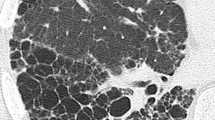Abstract
The purpose of this study is to evaluate the accuracy and inter-observer agreement of a quantitative pulmonary surface irregularity (PSI) score on high-resolution chest CT (HRCT) for predicting transplant-free survival in patients with IPF. For this IRB-approved HIPAA-compliant retrospective single-center study, adult patients with IPF and HRCT imaging (N = 50) and an age- and gender-matched negative control group with normal HRCT imaging (N = 50) were identified. Four independent readers measured the PSI score in the midlungs on HRCT images using dedicated software while blinded to clinical data. A t-test was used to compare the PSI scores between negative control and IPF cohorts. In the IPF cohort, multivariate cox regression analysis was used to associate PSI score and clinical parameters with transplant-free survival. Inter-observer agreement for the PSI score was assessed by intraclass correlation coefficient (ICC). The technical failure rate of the midlung PSI score was 0% (0/100). The mean PSI score of 5.38 in the IPF cohort was significantly higher than 3.14 in the negative control cohort (p < .001). In the IPF cohort, patients with a high PSI score (≥ median) were 8 times more likely to die than patients with a low PSI score (HR: 8.36; 95%CI: 2.91–24.03; p < .001). In a multivariate model including age, gender, FVC, DLCO, and PSI score, only the PSI score was associated with transplant-free survival (HR:2.11 per unit increase; 95%CI: 0.26–3.51; p = .004). Inter-observer agreement for the PSI score among 4 readers was good (ICC: 0.88; 95%CI: 0.84–0.91). The PSI score had high accuracy and good inter-observer agreement on HRCT for predicting transplant-free survival in patients with IPF.









Similar content being viewed by others
Data Availability
The datasets generated and/or analyzed during the current study are available from the corresponding author upon request.
References
Richeldi L, Collard HR, Jones MG. Idiopathic pulmonary fibrosis. Lancet 2017; 389:1941-1952
Ley B, Collard HR, King TE, Jr. Clinical course and prediction of survival in idiopathic pulmonary fibrosis. Am J Respir Crit Care Med 2011; 183:431-440
Raghu G, Collard HR, Egan JJ, et al. An official ATS/ERS/JRS/ALAT statement: idiopathic pulmonary fibrosis: evidence-based guidelines for diagnosis and management. Am J Respir Crit Care Med 2011; 183:788-824
Kim HJ, Perlman D, Tomic R. Natural history of idiopathic pulmonary fibrosis. Respir Med 2015; 109:661-670
Gleeson F, Fraser E. Hyperpolarized Xenon MRI, Further Evidence of Its Use in Progressive Pulmonary Fibrosis? Radiology 2022; 305:697-698
Hunninghake GM. A new hope for idiopathic pulmonary fibrosis. N Engl J Med 2014; 370:2142-2143
Nathan SD, Meyer KC. IPF clinical trial design and endpoints. Curr Opin Pulm Med 2014; 20:463-471
Wu X, Kim GH, Salisbury ML, et al. Computed Tomographic Biomarkers in Idiopathic Pulmonary Fibrosis. The Future of Quantitative Analysis. Am J Respir Crit Care Med 2019; 199:12–21
Sullivan DC, Obuchowski NA, Kessler LG, et al. Metrology Standards for Quantitative Imaging Biomarkers. Radiology 2015; 277:813-825
Raghu G, Collard HR, Anstrom KJ, et al. Idiopathic pulmonary fibrosis: clinically meaningful primary endpoints in phase 3 clinical trials. Am J Respir Crit Care Med 2012; 185:1044-1048
Nathan SD, Shlobin OA, Weir N, et al. Long-term course and prognosis of idiopathic pulmonary fibrosis in the new millennium. Chest 2011; 140:221-229
Ley B, Ryerson CJ, Vittinghoff E, et al. A multidimensional index and staging system for idiopathic pulmonary fibrosis. Ann Intern Med 2012; 156:684-691
Kusmirek JE, Martin MD, Kanne JP. Imaging of Idiopathic Pulmonary Fibrosis. Radiol Clin North Am 2016; 54:997-1014
Martin MD, Chung JH, Kanne JP. Idiopathic Pulmonary Fibrosis. J Thorac Imaging 2016; 31:127-139
Raghu G, Remy-Jardin M, Myers JL, et al. Diagnosis of Idiopathic Pulmonary Fibrosis. An Official ATS/ERS/JRS/ALAT Clinical Practice Guideline. Am J Respir Crit Care Med 2018; 198:e44-e68
Smith AD, Porter KK, Elkassem AA, Sanyal R, Lockhart ME. Current Imaging Techniques for Noninvasive Staging of Hepatic Fibrosis. AJR Am J Roentgenol 2019; 213:77-89
Smith A, Varney E, Zand K, et al. Precision analysis of a quantitative CT liver surface nodularity score. Abdom Radiol (NY) 2018; 43:3307-3316
Elkassem AA, Allen BC, Lirette ST, et al. Multiinstitutional Evaluation of the Liver Surface Nodularity Score on CT for Staging Liver Fibrosis and Predicting Liver-Related Events in Patients with Hepatitis C. AJR Am J Roentgenol 2021;
Pleasants R, Tighe RM. Management of Idiopathic Pulmonary Fibrosis. Ann Pharmacother 2019; 53:1238-1248
Chen A, Karwoski RA, Gierada DS, Bartholmai BJ, Koo CW. Quantitative CT Analysis of Diffuse Lung Disease. Radiographics 2020; 40:28-43
Nalysnyk L, Cid-Ruzafa J, Rotella P, Esser D. Incidence and prevalence of idiopathic pulmonary fibrosis: review of the literature. Eur Respir Rev 2012; 21:355-361
King TE, Jr., Pardo A, Selman M. Idiopathic pulmonary fibrosis. Lancet 2011; 378:1949-1961
Author information
Authors and Affiliations
Corresponding author
Ethics declarations
Ethics Approval
Informed consent was waived for this institutional review board–approved Health Insurance Portability and Accountability Act (HIPAA)–compliant retrospective single-center observational pilot study.
Additional information
Publisher's Note
Springer Nature remains neutral with regard to jurisdictional claims in published maps and institutional affiliations.
Supplementary Information
Below is the link to the electronic supplementary material.
Rights and permissions
Springer Nature or its licensor (e.g. a society or other partner) holds exclusive rights to this article under a publishing agreement with the author(s) or other rightsholder(s); author self-archiving of the accepted manuscript version of this article is solely governed by the terms of such publishing agreement and applicable law.
About this article
Cite this article
Elkassem, A.M.A., Mresh, R., Farag, A. et al. Pulmonary Surface Irregularity Score as a New Quantitative CT Marker for Idiopathic Pulmonary Fibrosis—a Pilot Study. J Digit Imaging 36, 2382–2391 (2023). https://doi.org/10.1007/s10278-023-00896-9
Received:
Revised:
Accepted:
Published:
Issue Date:
DOI: https://doi.org/10.1007/s10278-023-00896-9




